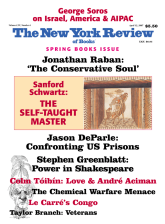In response to:
Who Was Milton Friedman? from the February 15, 2007 issue
To the Editors:
Paul Krugman’s “Who Was Milton Friedman?” [NYR, February 15] is the best brief popular summary I have thus far read of the contributions of Professor Friedman, “the economist’s economist” and the greatest exponent of free markets since Adam Smith as Krugman rightly contends. Other well-known popularizers like J. Kenneth Galbraith and Walter Heller, contemporaries of Friedman, could never have received such plaudits from their professional peers.
Friedman’s contributions to social policies, resulting from his significant theoretical analyses based upon, as Krugman notes, the assumption of rational choice, were clearly described in the New York Review essay, but a few other important results of his influence were missed. Much has been written about his and his students’ (“the Chicago Boys”) impact on the significant improvement of the economy during the Chilean dictatorship, but neither Krugman nor others even in memoriam have noted Friedman’s effect on Chinese economic policy at crucial periods in its development. When he first visited China in 1980 the only policy guidelines the authorities set down following the breakdown of Mao’s crumbling disorder were so-called pragmatic rules: “cross the river and feel the rocks” and then “seek the truth from facts.” The “river” was not named and the place to “look” was not specified. In the meetings he had with the Chinese leaders, Friedman strongly emphasized the importance of unfettered markets, pointing to China’s neighbor, Hong Kong, as a model to be followed.
This indeed, up to a point, is the road that has been taken. Again in 1988, the Chinese authorities, deeply worried by double-digit inflation which they knew undercut the Nationalists before 1949, sought his advice. Rumors had been spreading then that in Shanghai there was a run on the banks and even ordinary people were approaching foreigners with shouts of “wai hui, wai hui” (foreign exchange). The greatest spokesman for monetarism and his students had analyzed the causes of inflation in more than a dozen countries and had persuasively shown that the quantity theory of money works, that inflation indeed is a phenomenon of “too much money chasing too few goods,” and that the application of price controls and rationing was a “cure” which would only worsen the situation. Friedman’s advice was taken and since then China’s inflation has been within a small, acceptable range.
Further missing from Krugman’s summary is Friedman’s theoretical contribution to the adoption of flexible foreign exchange rates. Until his analysis, flexibility was rejected on the grounds that such rates would be unacceptably unstable because of speculation. And it was Friedman whose faith in free markets led to his promulgating the negative income tax. When families’ incomes fall below a certain level, they should be sent checks, using the money as they see fit. Missing also is Friedman’s contribution to statistics—a nonparametric test is named after him. Whether his contributions will stand up to the test of time remains to be seen, but as he was so fond of saying: “the proof of the pudding is in the eating.” Or as Einstein similarly said about theoretical physics: “the test of truth is experience.”
Bertrand Horwitz
Asheville, North Carolina
Paul Krugman replies:
I wasn’t aware of the China story, and am glad to have it out there.
I didn’t bring up exchange rate policy because I don’t think Friedman can be said to have made a deep intellectual contribution on the subject. Nonetheless, his advocacy of flexible rates does illustrate two of his great virtues.
First, on this as on other issues he showed himself much less doctrinaire and much more realistic than many of his acolytes: many conservative economists are drawn to visions of a restored gold standard or a world currency, dismissing the problems such a system would create; Friedman knew better.
Second, his famous paper on flexible rates is a masterpiece of writing, with a brilliant analogy: achieving international adjustment by changing the exchange rate, rather than by depending on thousands of firms to change their prices, is like shifting to daylight savings time, rather than depending on thousands of firms to change their working hours.
This Issue
April 12, 2007



